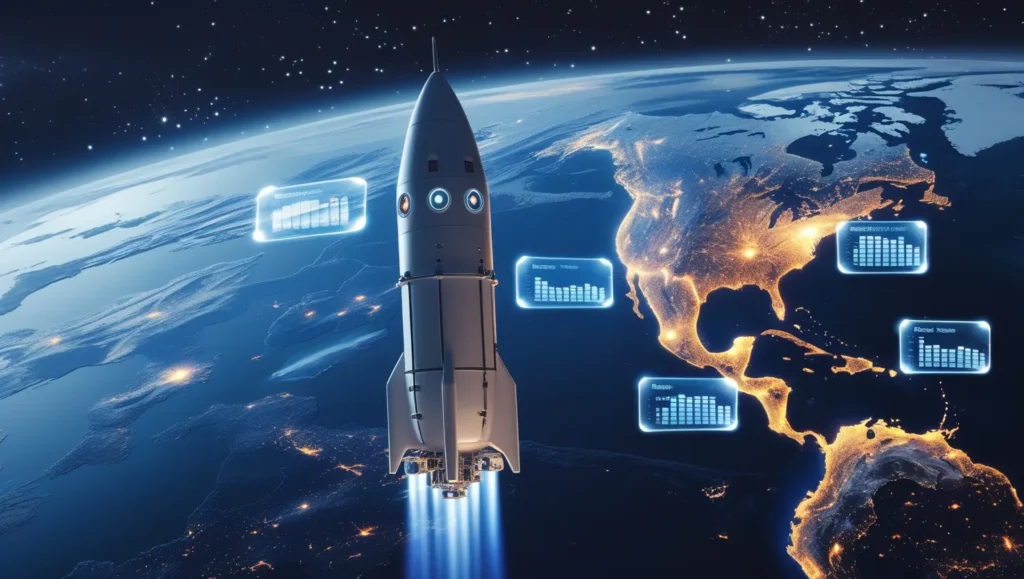The concept of space tourism has leaped from the pages of science fiction into a rapidly evolving reality. Driven by technological breakthroughs and billionaire entrepreneurs, the competition to bring civilians to the final frontier is heating up. No longer limited to astronauts, space tourism is transforming travel, exploration, and our understanding of what’s possible beyond Earth.
So, who are the key players shaping this groundbreaking industry? Let’s explore the top companies leading the charge, their achievements, and what sets them apart in this cosmic race.
The Space Tourism Boom
Space tourism is no longer a distant dream; it’s a thriving sector of the aerospace industry, fueled by innovation and the public’s growing fascination with the cosmos. As technology advances and costs gradually decrease, companies are racing to offer safe, accessible, and luxurious experiences to private citizens. From suborbital joyrides to orbital missions and even lunar expeditions, the possibilities for space travel are expanding at an unprecedented pace.
1. SpaceX: Revolutionizing Space Travel
Company Overview
Founded by Elon Musk in 2002, SpaceX is at the forefront of reusable rocket technology. Musk’s vision includes reducing space travel costs and making humanity a multi-planetary species.
Key Milestones
- 2008: Falcon 1 became the first privately developed liquid-fueled rocket to reach orbit.
- 2012: The Dragon spacecraft became the first private spacecraft to dock with the International Space Station (ISS).
- 2020: Successfully launched the Crew Dragon spacecraft with astronauts aboard, marking a new era in private spaceflight.
Space Tourism Services
- Orbital Missions: Multi-day trips around Earth using the Crew Dragon spacecraft, as seen in the historic Inspiration4 mission in 2021.
- Lunar Tourism: SpaceX plans lunar flybys, including the highly anticipated dearMoon project, funded by Japanese billionaire Yusaku Maezawa, using the Starship.
Competitive Edge
SpaceX’s reusable rockets, such as the Falcon 9 and Starship, have drastically lowered launch costs, making it a dominant force in space tourism.
2. Blue Origin: Suborbital Luxury
Company Overview
Jeff Bezos founded Blue Origin in 2000 with the mission to make space travel accessible and sustainable through reusable rocket technology.
Key Milestones
- 2015: New Shepard became the first reusable rocket to complete a successful flight and landing.
- 2021: Blue Origin’s first crewed flight included Jeff Bezos, marking a significant milestone in suborbital tourism.
Space Tourism Services
- New Shepard Flights: Passengers enjoy 10 minutes of weightlessness and breathtaking views from beyond the Kármán line.
- Features: Spacious capsules with large panoramic windows ensure a luxurious and immersive experience.
Competitive Edge
Blue Origin focuses on luxury and comfort, positioning itself as a premium provider for high-net-worth individuals.
3. Virgin Galactic: Adventure for the Everyday Traveler
Company Overview
Founded by Richard Branson in 2004, Virgin Galactic offers suborbital flights aboard its innovative spaceplanes, aiming to make space tourism more accessible.
Key Milestones
- 2004: Won the Ansari X Prize for the first privately-funded crewed spaceflight.
- 2021: Richard Branson completed a suborbital flight aboard VSS Unity, showcasing the company’s capabilities.
Space Tourism Services
- Suborbital Spaceplanes: Passengers experience a thrilling launch, a few minutes of weightlessness, and stunning views of Earth.
- Pre-Flight Experience: Luxurious training facilities enhance the journey.
Competitive Edge
Virgin Galactic targets thrill-seekers and adventure enthusiasts, offering tickets priced at $450,000.
4. Axiom Space: Luxury in Orbit
Company Overview
Founded in 2016, Axiom Space specializes in orbital tourism and is working toward building the first commercial space station.
Key Milestones
- 2022: Sent the first all-private crew to the ISS aboard SpaceX’s Crew Dragon.
- Future Plans: Development of luxury private modules for orbital stays.
Space Tourism Services
Tourists can stay aboard the ISS, enjoying life in microgravity, with options for light research or leisure activities.
Competitive Edge
Axiom offers an immersive and luxurious orbital experience, appealing to those seeking longer and more exclusive space stays.
5. Space Perspective: Sustainable Space Tourism
Company Overview
Founded in 2019, Space Perspective takes a unique approach to space tourism with its high-altitude balloon rides.
Key Milestones
- Developed the Spaceship Neptune, a pressurized capsule that provides a serene and sustainable journey to the edge of space.
- Plans to launch commercial operations by 2025.
Space Tourism Services
Passengers ascend to 100,000 feet during a six-hour trip, enjoying panoramic views of Earth from the comfort of a spacious, eco-friendly capsule.
Competitive Edge
Space Perspective appeals to eco-conscious travelers seeking a gentle, non-rocket-based space experience.
6. Sierra Space: Dreaming Big with the Dream Chaser
Company Overview
Sierra Space, a subsidiary of Sierra Nevada Corporation, is making waves with its versatile Dream Chaser spaceplane and plans for a commercial space station.
Key Milestones
- Secured NASA contracts for cargo missions to the ISS.
- Partnered with Blue Origin to develop the Orbital Reef, a next-generation commercial space station.
Space Tourism Services
The Dream Chaser spaceplane and Orbital Reef offer future opportunities for orbital stays and exploration.
Competitive Edge
Sierra Space’s partnerships and innovative spaceplane designs position it as a rising star in the industry.
FAQs
How much does space tourism cost?
Prices range from $250,000–$450,000 for suborbital flights to tens of millions for orbital missions.
Is space tourism safe?
Companies prioritize passenger safety with rigorous testing and advanced training programs.
What kind of training is required?
Training typically involves adapting to weightlessness, handling g-forces, and learning emergency procedures.
How long do space tourism flights last?
Suborbital flights last about 10 minutes in weightlessness, while orbital missions can span several days.
Who can participate?
Passengers must meet basic health and fitness criteria, with age and physical condition being key factors.
Conclusion: A New Frontier for Exploration
The race for space tourism is reshaping the aerospace industry. Whether it’s SpaceX’s vision for Mars, Blue Origin’s luxury suborbital flights, or Space Perspective’s eco-friendly approach, each company offers a unique take on the cosmic journey. As technology advances, space travel may one day become an accessible reality for all.
For now, space tourism remains a premium experience—but one that promises memories and views that are truly out of this world.

